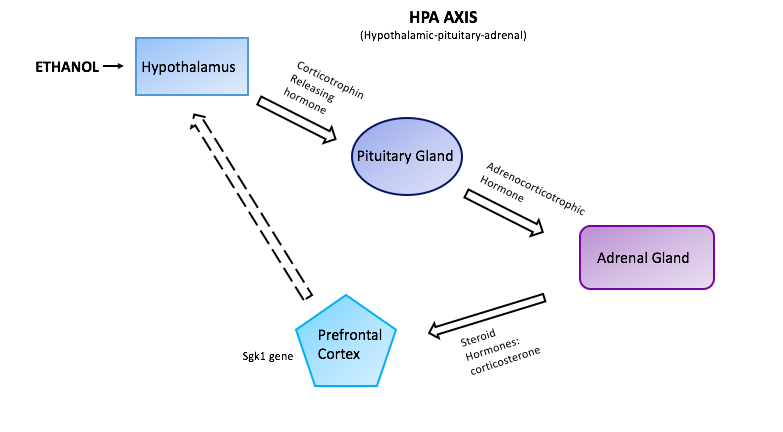A constant intake of alcohol can lead to an addiction known as alcohol use disorder(AUD). The addiction can hinder many tasks, due to changes in the brain region (neuroplasticity.) Unfortunately, a cure has not been developed to help treat this condition that effects millions of people in the United States.
Sgk1 is part of the Hypothalamic-pituitary-adrenal (HPA) axis(Fig. 1). The HPA axis responds to stress in the body connecting two major systems (endocrine and nervous system.) A major goal for the HPA axis is to maintain a balance by making sure levels of chemical signals aren't too high or too low (Alschuler, 2016). Fig. 1 shows the pathway of the signaling hormones, which cause the adrenal gland to release corticosterone into the blood stream influencing the transcription factors of sgk1.
Costin, et al. (2013) carried out a detailed study to understand the consequences of ethanol consumption on Sgk1 via HPA axis. The experiment started off comparing sgk1 and sgk1.1, in order to select the correct version of the gene. Since sgk1/sgk1.1 are encoded at different start positions having different function. Then measured how frequently SGK1 is expressed after ethanol consumption. Since, the release of corticosterone influences sgk1 in prefrontal cortex. The amount of corticosterone in the blood following ethanol intake was also obtained. Furthermore, a group of mice with adrenal glands vs without adrenal glands were used to compared corticosterone and sgk1 mRNA levels. Another experiment measured glucocorticoid receptor bound to sgk1 promotor region, giving a better understanding of the molecular pathway. The last couple experiment focus on the protein level of sgk1 with ethanol consumption. These experiments were conducted in the hopes to obtain valuable data to contribute to the cure to alcoholism.
